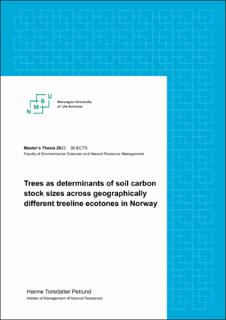| dc.description.abstract | Treelines in boreal regions migrate uphill as a consequence of global warming. The transition from previous open tundra to forest will likely influence alpine soil carbon stores, and there is considerable concern that increased carbon effluxes from the soil to the atmosphere will induce positive feedback on global warming. Thus, in order to predict what future climate change could mean for soil carbon stores in the forest-tundra ecotone, knowledge about the current carbon stores along the forest-tundra gradient is key. My objective was therefore to look at trees as determinants of soil carbon stock sizes across geographically different treelines. Specifically, I investigated whether there is a difference between carbon stocks in forest and tundra soils in treeline ecotones, and modeled the relationship between soil carbon stocks and tree biomass in treelines at different spatial scales.
To achieve this, carbon stocks were calculated for surface soil samples, together constituting soil sample lines, collected in forest and tundra at 34 treelines along an extensive north-south gradient in Norway. Remote sensing data acquired by drone were supplemented by field collected tree data, and used to estimate tree biomass around soil sample lines. Statistical tests were performed, and mixed models incorporating soil carbon stocks and tree biomass as variables were developed for buffer zones of different sizes.
The results showed that soil carbon stocks in forest and tundra were not significantly different. Moreover, there was not a clear relationship, positive or negative, between soil carbon stocks and tree biomass for any of the buffer zones. Tree biomass therefore seemed to be a weak determinant of soil carbon stock sizes irrespective of spatial scale. However, what study site soil sample lines originated from was important.
A possible explanation for these findings is that increased litter inputs in forest soils are counterbalanced by increased microbial decomposition. In addition, potential implications of study design are discussed, as well as potential sources of error. Complex local interactions between various abiotic and biotic factors may explain the importance of study site in determining soil carbon stock sizes. This site-specificity makes it difficult to predict what consequences future changes in the treeline will have for the soil carbon stocks, but in general my results indicate that a transition from tundra to forest will not cause a net increase in soil carbon losses. More information is needed to get a deeper understanding of carbon dynamics at Norwegian forest-tundra ecotones, and to develop management strategies that maximize carbon storage at treelines and mitigate global warming. | |
